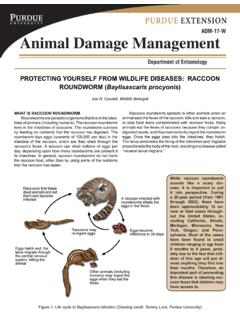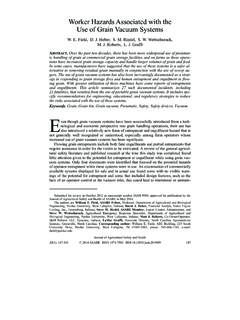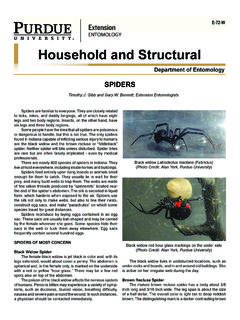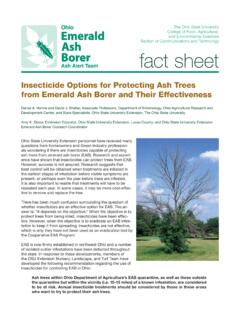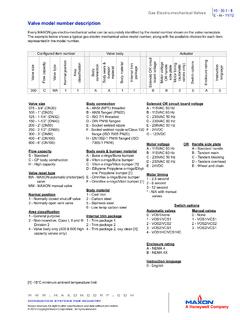Transcription of A Pictorial Key to the Order of Adult Insects
1 60A Pictorial Key to the Order of Adult Insectswingedwingless(go to page 64)front wings hardened , leathery or parchmentlike at least at the basefront wings membranous(go to page 61)chewing mouthpartssucking mouthpartswithoutpincer-likecerciwithpin cer-likecercifront wings leatheryat base andmembranous at endfront wings of uniform textureDERMAPTERA(earwigs)HEMIPTERA(true bugs)HOMOPTERA(leafhoppers, planthoppers, cicadas, spittlebugs)front wings with branched veinsA. front wings hard, without veinsCOLEOPTERA(beetles)jumping insectsA. hind femur enlargedB. tarsi with four or fewer segmentswalking insectsA.
2 Hind femur not enlargedB. tarsi with five segmentsORTHOPTERA(crickets, katydids, grasshoppers)DICTYOPTERA(roaches, mantids, walkingsticks)AABBA61continued from key page 60A. pronotum extended over abdomentwo wingsfour wingswings with few or no scales; without coiled proboscispronotum not extended over abdomenA. wings usually covered with scalesB. mouthparts consist of coiled proboscisvery slender wing with fringe of hairs as long as wing is wideno fringe of hairs, or if present, not as long as wing is wideend of abdomen without noticeable appendagesend of abdomen with style or thread-like tailA.
3 With haltere-like organs in front of wingsB. with halteres behind wingsA. style-like tailB. two or three thread-like tailsORTHOPTERA(pigmy grasshoppers)LEPIDOPTERA(butterflies and moths)THYSANOPTERA(thrips)(go to page 62)COLEOPTERA(male stylopids)DIPTERA(flies, mosquitoes, gnats, midges)HOMOPTERA(male scales)EPHEMEROPTERA(mayflies)AAAABBB62c ontinued from key page 61A. piercing-sucking mouthpartshind wings equal to or larger than front wings(go to page 63)hind wings smaller than front wingsno long abdominal appendagesB. chewing mouthpartsabdomen with two or three thread-like tailsB.
4 Antennae as long as body; wings and body often with scalesHOMOPTERA(cicadas, leafhoppers, planthoppers, spittlebugs)EPHEMEROPTERA(mayflies)HYMEN OPTERA(bees, wasps, ichneumons)TRICHOPTERA(caddisflies)Atars i two or three segmentedtarsi with more than three segments (usually five)A. antennae shorter than body; no noticeable scalesPSOCOPTERA(barklice, booklice)ABB63continued from key page 62mouthparts close to eyemouthparts at end of beak-like structure some distance from eyeA. bristle-like inconspicuous antennaeB. antennae apparently with several segmentsNEUROPTERA(lacewings, mantispids, owlflies, antlions)ISOPTERA(termites)PLECOPTERA(st oneflies)Ahind wings with enlarged anal area folded fan-like; wings tend to curl around the body lengthwiseORTHOPTERA(tree crickets)all legs of walking typeABODONATA(dragonflies, damselflies)wings heldflat over abdomenwings never heldflat over abdomenBhind wings without enlarged anal area folded fan-like.
5 Wings do not tend to curl around the body lengthwiseMEGALOPTERA(dobsonflies, fishflies, alderflies)hind legs modified for jumpingMECOPTERA(scorpionflies)A. cerci usually long; more than eight segmentsB. cerci short; with two to eight segments64continued from key page 60antennae presentantennae absentA. collophore present;B. spring-like organ usually presentTHYSANURA(silverfish)AABBHOMOPTER A(scales)(go to page 65)legs absenthead and thorax separatehead and thorax fusedCOLEOPTERA(female stylopoids)DIPTERA(louse flies, bat flies)legs presentboth collophore and spring-like organ absentthree tail-like appendages presentlong tail-likeappendages absentbody not flattenedA.
6 Body flattened laterallyB. or dorsoventrally(go to page 66)COLLEMBOLA(springtails)65continued from key page 64body flattened dorsoventrallybody flattened laterallyASIPHONAPTERA(fleas)A. antennae longer than headantennae shorter than headsucking mouthparts externally visibleno sucking mouthparts externally visibleB. antennae shorter than headDIPTERA(louse flies and bat flies)antennae longer than headA. tiny Insects ; tarsi with two or three segmentsB. large Insects ; tarsi with five segmentsPSOCOPTERA(booklice, barklice)DICTYOPTERA(roaches, mantids, walkingsticks)A. head wider than thorax at point of attachment to thoraxB.
7 Head narrower than thorax at point of attachment to thoraxMALLOPHAGA(biting lice)ANOPLURA(sucking lice)BABABHEMIPTERA(true bugs)66 continued from key page 64abdomen and thorax not narrowly joined togetherabdomen and thorax narrowly joined togetherLEPIDOPTERA(female cankerworm)body covered with scalesbody not covered with scalesTHYSANOPTERA(thrips)tarsal claws absenttarsal claws presentHYMENOPTERA(ants)piercing-sucking mouthpartschewing mouthpartscornicles absentA. cornicles usually presentwith distinct head and eyeswithout distinct head and eyesHEMIPTERA(bed bugs)HOMOPTERA(female scales)HOMOPTERA(aphids)DERMAPTERA(earwi gs)abdominal forceps present;entire body rather hard and brown coloredabdominal forceps absent(go to page 67)AA67continued from key page 66A.
8 Mouthparts at end of beak-like structure some distance from eyemouthparts not elongated, close to eyesMECOPTERA(scorpionflies)PSOCOPTERA(b arklice and booklice)cerci presentB. antennae shorter than one-fourth of body lengthAcerci absentA. antennae longer than one-third of body lengthCOLEOPTERA(female stylopids)body soft and pale coloredbody leathery and usually grey or dark coloredORTHOPTERA(crickets)three to five tarsal segmentsA. basal segment of front tarsi about same size as ones immediately followingISOPTERA(termites)ABA
